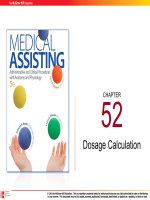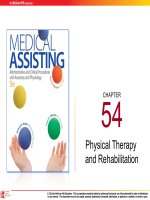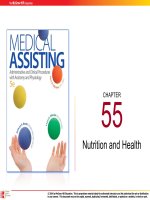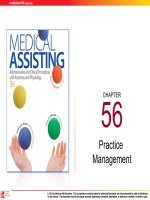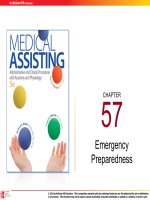Medical assisting Administrative and clinical procedures (5e) Chapter 52 Dosage calculation
Bạn đang xem bản rút gọn của tài liệu. Xem và tải ngay bản đầy đủ của tài liệu tại đây (1.07 MB, 42 trang )
CHAPTER
52
Dosage Calculation
© 2014 by McGraw-Hill Education. This is proprietary material solely for authorized instructor use. Not authorized for sale or distribution
in any manner. This document may not be copied, scanned, duplicated, forwarded, distributed, or posted on a website, in whole or part.
52-2
Learning Outcomes
52.1 Explain the role of the medical
assistant to ensure safe dosage
calculations.
52.2 Identify systems of measurements and
their common uses.
52.3 Convert among systems of
measurements.
© 2014 by McGraw-Hill Education. This is proprietary material solely for authorized instructor use. Not authorized for sale or distribution
in any manner. This document may not be copied, scanned, duplicated, forwarded, distributed, or posted on a website, in whole or part.
52-3
Learning Outcomes
52.4 Execute dosage calculations
accurately.
52.5 Calculate dosages based upon body
weight and body surface area.
© 2014 by McGraw-Hill Education. This is proprietary material solely for authorized instructor use. Not authorized for sale or distribution
in any manner. This document may not be copied, scanned, duplicated, forwarded, distributed, or posted on a website, in whole or part.
52-4
Introduction
• Administer medications
– Close attention to detail
– Dosage calculation must be accurate
• Basic math
• Systems of measurement
• Conversions within or between measurement
systems
• Calculations for special patient populations
© 2014 by McGraw-Hill Education. This is proprietary material solely for authorized instructor use. Not authorized for sale or distribution
in any manner. This document may not be copied, scanned, duplicated, forwarded, distributed, or posted on a website, in whole or part.
52-5
Ensuring Safe Dosage Calculations
• Minor math errors major error in dosage
• Each time you calculate a dosage
– Analyze the problem
– Estimate a range
– Is the answer reasonable?
© 2014 by McGraw-Hill Education. This is proprietary material solely for authorized instructor use. Not authorized for sale or distribution
in any manner. This document may not be copied, scanned, duplicated, forwarded, distributed, or posted on a website, in whole or part.
52-6
Measurement Systems
• Three systems
– Metric ~ most common
– Apothecary
– Household
• Focus on the basic units of
– Volume
– Weight
© 2014 by McGraw-Hill Education. This is proprietary material solely for authorized instructor use. Not authorized for sale or distribution
in any manner. This document may not be copied, scanned, duplicated, forwarded, distributed, or posted on a website, in whole or part.
52-7
Metric System
• Based on multiples of 10
• Basic units
– Volume = liter (L)
– Weight = gram (g)
• Prefixes indicate multiples of each
© 2014 by McGraw-Hill Education. This is proprietary material solely for authorized instructor use. Not authorized for sale or distribution
in any manner. This document may not be copied, scanned, duplicated, forwarded, distributed, or posted on a website, in whole or part.
52-8
Metric System
Prefix
Kilo-
Base
unit
Centi-
Milli-
Micro-
Value
Weight
× 1000
kilogram
-gram
÷ 100
centigram
÷ 1000
milligram
÷ 1,000,000
microgram
(kg)
(g)
(cg)
(mg)
(mcg)
1000 g
1g
0.01 g
0.001 g
0.000001 g
kiloliter
liter
centiliter
milliliter
microliter
(kL)
(L)
(cL)
(mL)
(mcL)
1000 L
1L
0.01 L
0.001 L
0.000001 L
Volume
© 2014 by McGraw-Hill Education. This is proprietary material solely for authorized instructor use. Not authorized for sale or distribution
in any manner. This document may not be copied, scanned, duplicated, forwarded, distributed, or posted on a website, in whole or part.
52-9
Apothecary and Household Systems
• Apothecary
– Weight
– Volume
• Fluid ounces
• Drams
• Fluid drams
• Ounces
• Pint quart
• Pounds
© 2014 by McGraw-Hill Education. This is proprietary material solely for authorized instructor use. Not authorized for sale or distribution
in any manner. This document may not be copied, scanned, duplicated, forwarded, distributed, or posted on a website, in whole or part.
52-10
Apothecary and Household Systems
• Household – only volume
– Drops
– Ounces
– Teaspoons and
tablespoons
– Cups
– Pints, quarts, and
gallons
© 2014 by McGraw-Hill Education. This is proprietary material solely for authorized instructor use. Not authorized for sale or distribution
in any manner. This document may not be copied, scanned, duplicated, forwarded, distributed, or posted on a website, in whole or part.
52-11
Apothecary and Household Systems
Apothecary Units
Equivalent
Measures of Volume
8 fluid drams (fl dr) 1 fluid ounce (fl oz)
16 fl oz 1 pint (pt)
2 pt 1 quart (qt)
4 qt 1 gallon (gal)
Measures of Weight
60 gr 1 dram (dr)
8 dr 1 ounce (oz)
16 oz 1 pound (lb)
© 2014 by McGraw-Hill Education. This is proprietary material solely for authorized instructor use. Not authorized for sale or distribution
in any manner. This document may not be copied, scanned, duplicated, forwarded, distributed, or posted on a website, in whole or part.
52-12
Apothecary and Household Systems
Household
Units
Equivalent
Measures of Volume
60 drops* (gtt) = 1 teaspoon (tsp)
3 tsp = 1 tablespoon (tbsp)
6 tsp =
8 oz =
2c=
4c=
1 ounce (oz) or 2
tbsp
1 cup (c)
1 pint (pt)
1 quart (qt) or 2 pt
© 2014 by McGraw-Hill Education. This is proprietary material solely for authorized instructor use. Not authorized for sale or distribution
in any manner. This document may not be copied, scanned, duplicated, forwarded, distributed, or posted on a website, in whole or part.
52-13
Apply Your Knowledge
Match the following: ANSWER:
A. Metric
B units of measurements are the
same as in the household system B. Apothecary
C drops
C. Household
A multiples of ten
C only uses units of volume
B fluid dram
A microliter
© 2014 by McGraw-Hill Education. This is proprietary material solely for authorized instructor use. Not authorized for sale or distribution
in any manner. This document may not be copied, scanned, duplicated, forwarded, distributed, or posted on a website, in whole or part.
Conversions Within and Between
Measurement Systems
52-14
• Rules for converting within the Metric
System
1. Move the decimal point to the right when you
convert from a larger to a smaller unit.
This is dividing.
2. Move the decimal point to the left when you
convert from a smaller to a larger unit.
This is multiplying.
© 2014 by McGraw-Hill Education. This is proprietary material solely for authorized instructor use. Not authorized for sale or distribution
in any manner. This document may not be copied, scanned, duplicated, forwarded, distributed, or posted on a website, in whole or part.
52-15
Converting Within the Metric System
• Determine the direction and number of
places to move the decimal point
– A milliliter is three
decimal places
to the right of liter
– A kilogram is three
decimal places
to the left of a gram
© 2014 by McGraw-Hill Education. This is proprietary material solely for authorized instructor use. Not authorized for sale or distribution
in any manner. This document may not be copied, scanned, duplicated, forwarded, distributed, or posted on a website, in whole or part.
52-16
Converting Within the Metric System (cont.)
LEFT
3
© 2014 by McGraw-Hill Education. This is proprietary material solely for authorized instructor use. Not authorized for sale or distribution
in any manner. This document may not be copied, scanned, duplicated, forwarded, distributed, or posted on a website, in whole or part.
52-17
Converting Between Systems
• Be familiar with equivalent measures
• Conversion charts – check carefully before
administering a drug
1 teaspoon = 5 mL
1 tablespoon = 15 mL
1 pint = 480 mL
1 kg = 2.2 lbs
1 fl oz = 30 mL
1 fl oz = 2 tbsp
© 2014 by McGraw-Hill Education. This is proprietary material solely for authorized instructor use. Not authorized for sale or distribution
in any manner. This document may not be copied, scanned, duplicated, forwarded, distributed, or posted on a website, in whole or part.
52-18
Converting Between Systems (cont.)
© 2014 by McGraw-Hill Education. This is proprietary material solely for authorized instructor use. Not authorized for sale or distribution
in any manner. This document may not be copied, scanned, duplicated, forwarded, distributed, or posted on a website, in whole or part.
52-19
Converting Between Systems (cont.)
© 2014 by McGraw-Hill Education. This is proprietary material solely for authorized instructor use. Not authorized for sale or distribution
in any manner. This document may not be copied, scanned, duplicated, forwarded, distributed, or posted on a website, in whole or part.
52-20
Apply Your Knowledge
1. Which measuring system is most commonly
used?
ANSWER: The metric system.
2. Convert 25 grams to milligrams.
ANSWER:
1. Add a decimal point to the measurement: 25. g
2. Add 3 zeros so you can move the decimal point
three places to the right: 25.000 g
3. Move the decimal point to the right three places:
25,000
4. Change the unit: 25,000 mg
© 2014 by McGraw-Hill Education. This is proprietary material solely for authorized instructor use. Not authorized for sale or distribution
in any manner. This document may not be copied, scanned, duplicated, forwarded, distributed, or posted on a website, in whole or part.
52-21
Dosage Calculations
• Must be accurate
– Double check
– Have coworker check
• Use
– Proportion method
– Formula method
© 2014 by McGraw-Hill Education. This is proprietary material solely for authorized instructor use. Not authorized for sale or distribution
in any manner. This document may not be copied, scanned, duplicated, forwarded, distributed, or posted on a website, in whole or part.
Proportion Method for Dosage
Calculations
52-22
© 2014 by McGraw-Hill Education. This is proprietary material solely for authorized instructor use. Not authorized for sale or distribution
in any manner. This document may not be copied, scanned, duplicated, forwarded, distributed, or posted on a website, in whole or part.
Proportion Method for Dosage
Calculations (cont.)
52-23
© 2014 by McGraw-Hill Education. This is proprietary material solely for authorized instructor use. Not authorized for sale or distribution
in any manner. This document may not be copied, scanned, duplicated, forwarded, distributed, or posted on a website, in whole or part.
Proportion Method for Dosage
Calculations (cont.)
52-24
© 2014 by McGraw-Hill Education. This is proprietary material solely for authorized instructor use. Not authorized for sale or distribution
in any manner. This document may not be copied, scanned, duplicated, forwarded, distributed, or posted on a website, in whole or part.
52-25
Formula Method for Dosage Calculations
© 2014 by McGraw-Hill Education. This is proprietary material solely for authorized instructor use. Not authorized for sale or distribution
in any manner. This document may not be copied, scanned, duplicated, forwarded, distributed, or posted on a website, in whole or part.

